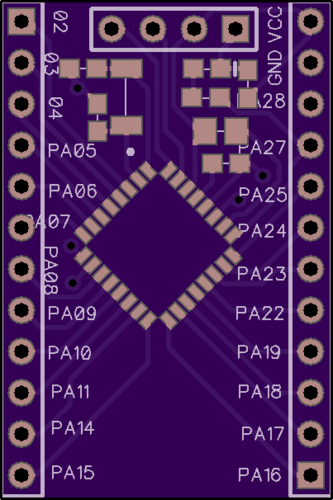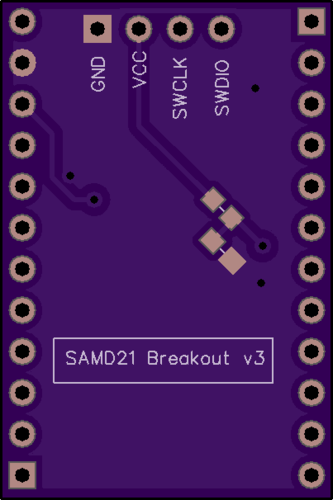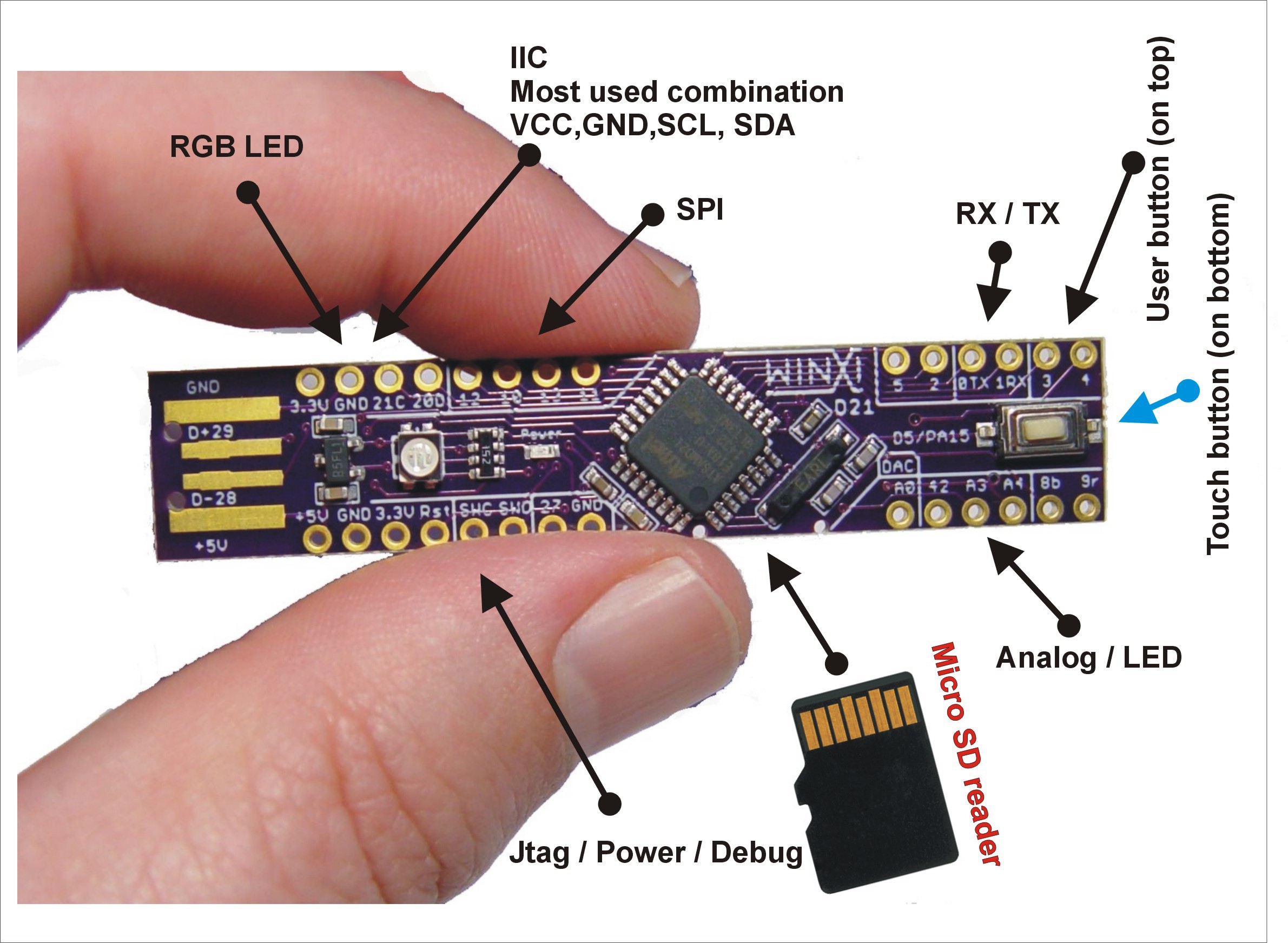nRF5 action!
-
Have you checked this ?
https://hackaday.io/project/10208-winxi-arduino-zero-pro-m0-stick-atsamd21e18And this one which I think is the closest to what you want to do ?
(32 pins chip, 2 layers, usb and basically the size of a nano)
https://hackaday.io/project/6276-sam-d20d21-breakout-boardIt probably would benefit from a few improvements but it's a good start I think ? Especially when author provides eagle files...
Thank you! Those are great finds. Yes, the second one has fewer parts than the first, and therefore closer to what I want to do.
Also, it's now clear that Sparkfun went through a lot of effort (and resorted to a 4-layer PCB) in order to maintain the "pro mini" style pinout on its board. I'm realizing now that--for present purposes--it's not worth the extra cost and effort of doing that. Instead, just doing a simple "breakout" type mapping, as the second Hackaday project did, is sufficient.
-
i agree with you for 4layers, it's not needed.
personally, i wouldn't go too much minimalist with decoupling, or usb, because it depends on what you connect then to your mainboard.. I see this on lot of boards, not following basic usb specs.. -
Yes that's why I say it needs some improvements.
Most of SAMD2x boards I see use some ferrite beads in addition to a bunch of capacitors. -
Looks as though the second one he didn't even bother with USB, even though he had the pads for it on his board. He did it all through the SWD connector. I'm planning to reduce that 10 pin debug connector to just 4 pins, since that's all my ST-LINK V2 interface has anyway. It should be arriving today:
https://www.amazon.com/gp/product/B0722WMDFQ/ref=oh_aui_detailpage_o00_s00?ie=UTF8&psc=1 -
Now that I think about it, I think I'll make a completely "dumb" breakout board, where it's just every pin of the SAMD21 mapped to a post, and it's only just the SAMD21 chip on the board. Then I can experiment on breadboard and figure out what I want and what works before finally reducing it to a subsequent PCB.
I suppose it makes sense, though, to put the 32.768khz crystal on the board though.
-
Now that I think about it, I think I'll make a completely "dumb" breakout board, where it's just every pin of the SAMD21 mapped to a post, and it's only just the SAMD21 chip on the board. Then I can experiment on breadboard and figure out what I want and what works before finally reducing it to a subsequent PCB.
I suppose it makes sense, though, to put the 32.768khz crystal on the board though.
-
@NeverDie it would also make sense to make at least the "basic" decoupling capacitors/pullups/...
You're right. So, I think this will probably be it then: 0_1496760742368_Schematic_for_SAMD21_TQFP32_Pro_Mini _v003.pdf
It's the guts of the sparkfun design, but with just one LED, and minus the usb, and with a 4 pin SWD connection, and the easiest possible mapping of chip pins to external pins.
What do you think?
-
On the other hand, at least during development, it seems a shame to lose the USB connection. I suppose maybe (?) the USB could be pumped through some kind of external 5v to 3.3v level shifter, and then I wouldn't need to put voltage converters on the board itself. It wouldn't any longer meet the official USB spec, but maybe it would work just the same. That in turn would help reduce the size and costs. Never tried that before with USB though, so it's an unknown to me as to whether it would work or not.
-
I can probably make it a bit more compact, but without the USB, this will be the approximate shape of it: 0_1496774768997_SAMD21_TQFP32_Breakout_v003.pdf
-
The whole thing is less than one square inch in size, so I went ahead and ordered the non-usb version from osh-park:


The silkscreen could be better, but it's good enough to test whether or not it's going to fly.
It appears there's plenty of space at the bottom for adding a USB connector, so I guess that will be next....
-
I don't see any decoupling capacitors or ferrite beads on the USB data circuit. According to the schematic ( https://cdn.sparkfun.com/datasheets/Dev/Arduino/Boards/sparkfun-samd21-mini-breakout-v10.pdf), USB_D- and USB_D+ just connect directly to pins PA24 and PA25 on the MCU.
-
What size pads are you guys using for your SAMD21 land pattern? Mine don't look right. The SAMD21 datasheet didn't actually give a land pattern. It just gave the size of the legs, and so I just made up a land pattern that was close to that. Looks too small compared to others that I'm seeing (e.g. on the Hackaday).
-
What size pads are you guys using for your SAMD21 land pattern? Mine don't look right. The SAMD21 datasheet didn't actually give a land pattern. It just gave the size of the legs, and so I just made up a land pattern that was close to that. Looks too small compared to others that I'm seeing (e.g. on the Hackaday).
@NeverDie said in Minimalist SAMD21 TQFP32 Pro Mini:
What size pads are you guys using for your SAMD21 land pattern? Mine don't look right. The SAMD21 datasheet didn't actually give a land pattern. It just gave the size of the legs, and so I just made up a land pattern that was close to that. Looks too small compared to others that I'm seeing (e.g. on the Hackaday).
Nevermind. I found the answer on page 10 of http://www.atmel.com/Images/Atmel-8826-SEEPROM-PCB-Mounting-Guidelines-Surface-Mount-Packages-ApplicationNote.pdf
-
I don't see any decoupling capacitors or ferrite beads on the USB data circuit. According to the schematic ( https://cdn.sparkfun.com/datasheets/Dev/Arduino/Boards/sparkfun-samd21-mini-breakout-v10.pdf), USB_D- and USB_D+ just connect directly to pins PA24 and PA25 on the MCU.
@NeverDie said in Minimalist SAMD21 TQFP32 Pro Mini:
I don't see any decoupling capacitors or ferrite beads on the USB data circuit. According to the schematic ( https://cdn.sparkfun.com/datasheets/Dev/Arduino/Boards/sparkfun-samd21-mini-breakout-v10.pdf), USB_D- and USB_D+ just connect directly to pins PA24 and PA25 on the MCU.
I saw that on the Adafruit board I think, and on the SenseBender gateway.
-
you should not add decoupling /ferite beads to the D+/D- lines.. At most, add a protection resistor of 30R (or there about) inline, to limit current flow. Also you can add a USB protection circuit with diodes externally..
The ferite bead / capacitors on the sensebender, is between the cable shield, and gnd on the device, to limit EMI on the cable shielding..
-
Just realizing that if I'm going to hand patch the 4 SWD wires onto the board anyway, then I really don't need an SWD block. Consequently, I'm now thinking the Hackaday guy had the right idea with making his entire node the width of a USB connector:

-
Just realizing that if I'm going to hand patch the 4 SWD wires onto the board anyway, then I really don't need an SWD block. Consequently, I'm now thinking the Hackaday guy had the right idea with making his entire node the width of a USB connector:

-
@NeverDie >> I'm now thinking the Hackaday guy had the right idea with making his entire node the width of a USB connector:
Really good idea. Just plug it into your box.
-
@Terrence
Yes, and by making the node the width of a USB connector, there's no wasted PCB that you'd get if the PCB were wider. -
@NeverDie Event though there seem to be many benefits to going narrow, what about enclosure sizes, where longer may not be as good as a smaller square?
@Terrence said in Minimalist SAMD21 TQFP32 Pro Mini:
@NeverDie Event though there seem to be many benefits to going narrow, what about enclosure sizes, where longer may not be as good as a smaller square?
I'll cross that bridge if I come to it. :)
Meanwhile, what I'm wondering is: just how wide should the PCB be? I tried looking up USB dimensions, but I get conflicting info:

I also tried measuring some with a micrometer. I think it's going to be something around 12mm. My PCB needs to be a minimum of 12.12mm wide in order to avoid pads of the SAMD21 being too close to the edge of the PCB. Is that too wide, or is it within tolerance?
